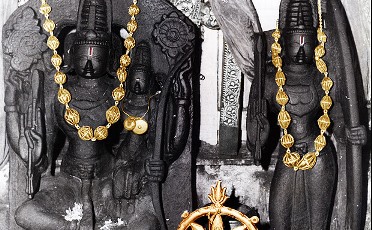 Situated on a hill, surrounded by the River Godavari, in Khammam District of Telangana, this sacred place has a long history dating back to the period of Ramayan, according to ancient texts. The name derives from the name of the hill – Bhadra (a devotee of the Lord, who lends his name to the hill – Bhadragiri) and achalm translating to a hill.
Situated on a hill, surrounded by the River Godavari, in Khammam District of Telangana, this sacred place has a long history dating back to the period of Ramayan, according to ancient texts. The name derives from the name of the hill – Bhadra (a devotee of the Lord, who lends his name to the hill – Bhadragiri) and achalm translating to a hill.
Earliest available records refer to the finding of idols of Lord Vykunta Rama, Sita and Lakshmana in the early part of the seventeenth century by a resident of the nearby bhadrireddypalem who also happened to be a fervent devotee of the Lord Rama. It is said that she was instructed by the Lord himself in her dream to find his Moorthy on the hill and to worship to attain salvation. Upon searching for the idols the morning after, she found them beneath an anthill. Cleaning away the mud with water from the river nearby, she started to offer the idols daily prayers. Soon a thatched mandapam was raised with the help of local villagers.
Later a tahsildhar of the polavancha paragana named Kancharala Gopanna while collecting dues on the behalf of his employer the Nawab of Golconda, popularly known as "Taneesha", happened to visit Bhadrachalam and found himself very attracted towards the Lord. Gopanna, himself was an ardent devotee of the Lord, proposed the construction of a temple and sought the financial help of the villagers. With contributions falling short, the villagers promised to pay back the Nawab's treasury, if Gopanna made use of the collected land revenues to construct the temple. Gopanna agreed and the construction went ahead.
The Nizam got furious and jailed Gopanna for 12 years for mishandling revenues. During those twelve cruel years at the hands of jailors, Gopanna prayed to the Lord to relieve him of the torture and sang many keerthanas in Lord Rama's praise. Just at a time when Gopanna was beginning to nurse the feeling that his prayers would go un-answered, Lord Rama and Lakshmana posing themselves as young servants of Gopanna named Ramoji and Lakshmoji, asked Taneesha to release Gopanna and repaid the entire amount of six lakhs in the form of gold coins to Taneesha and left the release orders under Gopanna's pillow. Thus Gopanna was released from prison and the Nawab realized that the supposed young servants of Gopanna were none other than Lord Rama and Lakshmama themselves. Impressed by the act, Taneesha became a devotee of the lord and offered to set aside the entire revenues from polavancha towards the temple activities in addition to providing pearls for Kalyana Mahotsavam. Taneesha also gave Gopanna land around Bhadrachalam to continue his services to the lord. Thus, Gopanna was recognized for his devotion and was popularized by the name "Bhakta Ramdas". The songs he composed during and after his release from prison became immensely popular and are still considered a benchmark to this day while the Nawab's offer of pearls on Kalyana Mahotsavam became a tradition, which continues to this day with the state's government sending pearls on its behalf, popularly known as "Mutyala Talambralu" every year on the occasion.
The present place is said to be the part of Dandakaranya, where Lord Rama, Sita and lakshmana spent their vanavasam and very near to the place where Ravana abducted Sita. The place popularly called Parnashala exists to this day. According to another popular version, Bhadra performed penance at the bank of river Godavari in this "Dandakaranya" to get grace of lord Rama and in countenance of his beloved God - The exulted "Rishi" implored Rama to be seated on his head, but Rama who was in search of his consort Sita gave promise to his Bhakta that his desire would be fulfilled on his way back, after finding Sita and accomplishing the process of punishing the wicked Ravana and establish 'Dharma'. Thus the sage had been in continuation of the frightened penance as Rama could not accomplish the promise in Ramavatara. Then Sri Mahavishnu manifested himself as Vykuntha Rama and rushed to his devotee Bhadra, signaling his arrival by blowing 'Shanku', accompanied by his consort Sita and brother Laxmana, resembling that of 'Gajendra Moksham' Thus, the moorthies of Rama (having four hands) - Shanku on the right, Chakra at his left and Dhanurbhana (Bow and Arrow in the rest two hands), Sita had condescended on the left lap of Rama and brother (at Rama's left) are existed. And the hill place where the Deities were seated on, was the head place of Bhadra - achalam (hill), thus this shrine was transformed into Bhadrachalam.